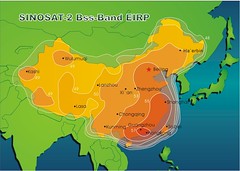China to Launch New Communications Satellite in October
We wrote last month about the Chinese launch of their seed-breeding satellite.
Now the Chinese hope to breed lots of new channels for millions of people with the launch of its SinoSat 2 satellite at the end of October:
A Chinese Chang Zheng (Long March) 3B carrier rocket is scheduled to launch the SinoSat 2 (a.k.a. Xinnuo 2), satellite… from Launch Complex 2 at the Xichang Satellite Launch Centre. According to Sun Laiyan, administrator of the China National Space Administration, the Xinnuo 2 large-capacity communications satellite, with an anti-jamming system, will provide direct television broadcasting services to the Chinese mainland, as well as Hong Kong, Macao and Taiwan. On Monday, August 4, the satellite left the production facility after receiving its final checks by the Commission of Science, Technology and Industry for National Defence. Xinnuo 2 is based on the Dongfanghong 4 platform and has been designed to work with the ChinaSat 9 satellite in the same orbit, to provide communications services to the Chinese mainland. The ChinaSat 9 satellite is based on the Spacebus 4000 C1 platform and will be positioned at 92.2 degrees east. The Xinnuo 2 satellite, which has taken China six years to develop, is designed to have a lifespan of 15 years, and operated in geosynchronous orbit at 110.5 deg E. China has managed to launch 70 satellites since the 1970’s, of which, currently only 20 are still in service today.
 China Daily has additonal information on how the Chinasat 9 and Sinosat 2 satellites will improve television coverage in local areas; the Asia-Pacific Broadcasting Union notes that the new satellite will provide up to 300 million mainland households with "access to cable-quality TV services that have so far been restricted to China’s more urban areas."
China Daily has additonal information on how the Chinasat 9 and Sinosat 2 satellites will improve television coverage in local areas; the Asia-Pacific Broadcasting Union notes that the new satellite will provide up to 300 million mainland households with "access to cable-quality TV services that have so far been restricted to China’s more urban areas."
The launch of SinoSat 9 comes just in time a new cultural great leap forward in China, as January, 2007 will bring the introduction of a Chinese version of America’s Next Top Model to Chinese television.
(The photo above shows the areas of coverage for the new satellite.)